Why you can trust TechRadar
We spend hours testing every product or service we review, so you can be sure you’re buying the best. Find out more about how we test.
Marshall Heston 120: two-minute review
The Marshall Heston 120 Dolby Atmos soundbar is a product that aims to make a mark in a world of hulking black boxes. This amp-inspired, meter-long bar is powered by 11 active drivers and looks to offer room-swallowing bass output, a colorful spatial impression, and top-tier music replication. Still, it comes with a price-tag that’s far from small. So, is it worth taking the plunge on the Marshall Heston 120?
Well, if you’re looking for a one-box soundbar (ie, no subwoofer or rear speakers) that’s capable of phenomenal Dolby Atmos and DTS:X performance, the answer is almost certainly yes. You get really impressive expansiveness from the Marshall Heston 120, with side-firing drivers providing mind-boggling width and up-firing tweeters presenting lifelike verticality. Would a multi-box alternative whip up an even more fleshed-out cinematic experience? Possibly. But for a standalone soundbar, it’s hard to beat the Heston 120.
Whether you’re watching movies with Dolby Atmos or not, the Marshall Heston 120 delivers truly exceptional performance. You’ll hear crystal-clear speech from the center channel whether you’re in Movie or Voice mode and, most of all, get to experience shockingly shaking bass from the Heston’s dual rear-facing subwoofers. Seriously, the bass rumble alone puts the Marshall Heston 120 right up there with the best soundbars around.
But something that truly sets the Heston 120 apart from a vast sea of competitors is its class-leading performance for music – whether you’re listening to an Atmos or stereo mix. With spotless channel separation, delicious depth, a broad soundstage, and wonderful control right across all frequencies, the Marshall Heston 120 is a musical maestro as well as a movie marvel.
Of course, given its price and one-box status, the Heston 120’s obvious rival is the Sonos Arc Ultra, which is easily one of the best Dolby Atmos soundbars that money can buy. The Marshall may not have a voice assistant or quite as much power as the Arc Ultra – but it does have HDMI passthrough (4K at 120Hz, too) and DTS support – a couple of factors that we really missed from the Arc Ultra.
And though the Arc Ultra is a rounded, clean-looking character, I have to say that the Heston 120 is a real work of art. Everything from its gold details, its amp-like aesthetic and its classy knurled metal dials truly screams premium. You should know that you might catch a few reflections on those tactile knobs when watching TV in low-lit spaces, depending on your angle – but still, they make for a unique, attractive addition.

The Heston 120 is a standalone soundbar in the truest sense. There are no additional speakers – at least not yet, though the Heston Sub 200 is coming later this year. And you won’t even find a remote here – everything is controlled via the flashy new Marshall app, which lets you flick through four sound modes, calibrate the bar to your room’s shape and size, adjust volume, EQ… you name it. I love the pure simplicity of this – I don’t want another remote laying around, personally.
You won’t find a display on the soundbar – everything you need to see is in that app – which may be more of a frustration for some. If you want to know whether the Heston 120 is playing Atmos, you’ll need to check the app.
I’ll drill into the finer details below, but if you just want the lowdown, then the Marshall Heston 120 is frankly an exemplary soundbar that fuses Marshall’s musical heritage with top-drawer cinematic sound for the modern era. It’s built to last – Marshall will even sell parts if something goes wrong – it sounds amazing, and… well, just look at it!
Yes it’s expensive and you may well be able to find a strong multi-box option at a similar cost. But if you want to take your movie-watching or music-listening experiences to the next level, all via one expertly crafted hub, the Marshall Heston 120 is my choice.
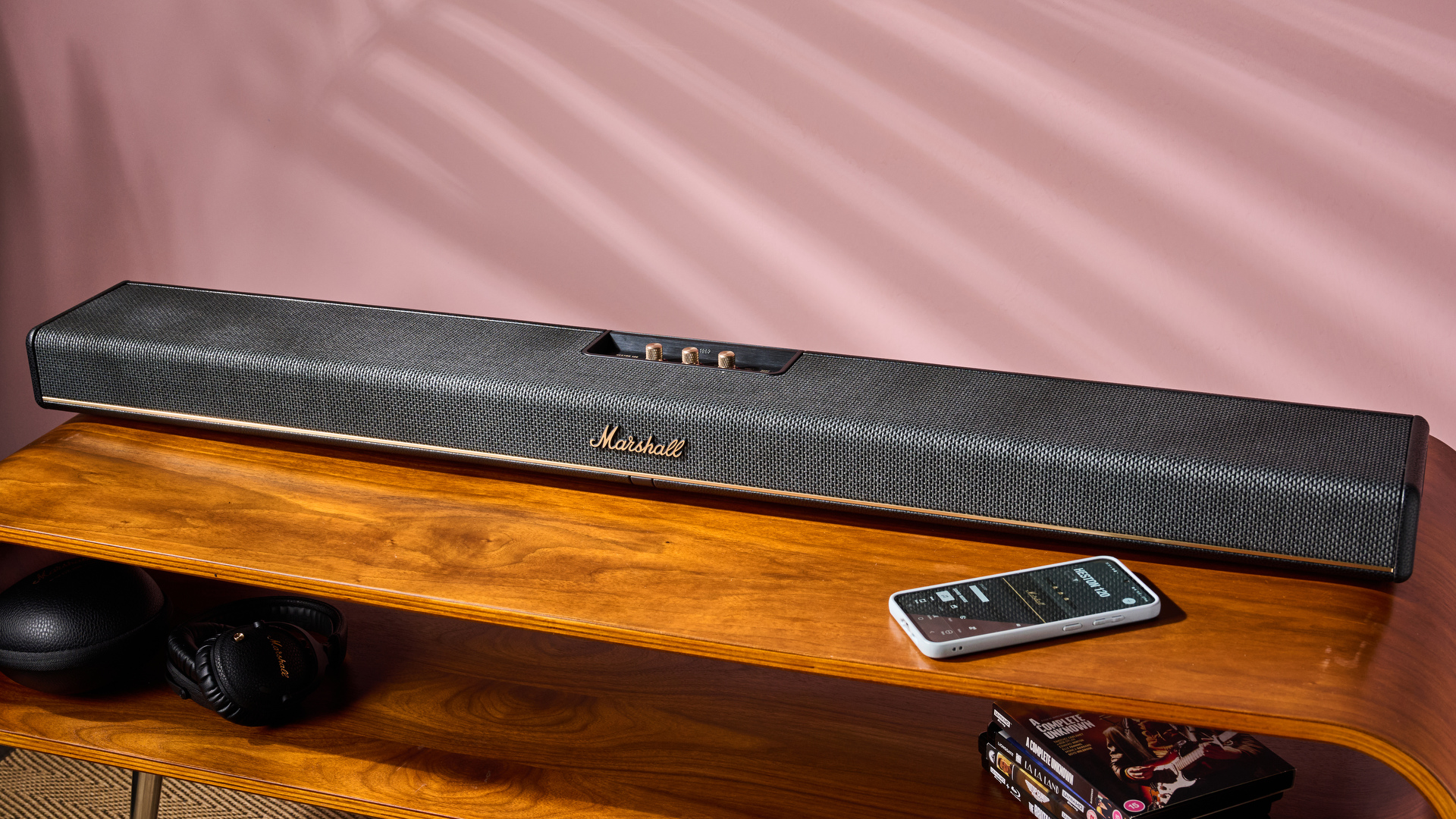
Marshall Heston 120 review: price & release date
- Priced at $999 / £899 / AU$1,799
- Launched on 3 June 2025
- Will also be available via select retailers from September 16, 2025
The Marshall Heston 120 released on 3rd June 2025 and is the very first soundbar Marshall has ever brought to market. It is, admittedly pretty pricey, coming in at $999 / £899 / AU$1,799. But even if it’s expensive, there are pricier all-in-one rivals. The Sonos Arc Ultra is £100 more for UK customers (the same in the US), while the Devialet Dione and Sony Bravia Theater Bar 9 carry list prices of $2,399 / £1,990 / AU$3,999 and $1,399 / £1,399 / AU$1,795 respectively.
Of course, you can get multi-box soundbar systems for a similar price or less – even the wonderful Samsung HW-Q990D can be found for only a touch more than the Heston across many territories. But this is a true all-in-one option that doesn’t rely on separate speakers for a full-sounding cinematic experience, so they’re different propositions in some ways.

Marshall Heston 120 review: Specs
Dimensions | 43.3 x 5.7 x 3.0 inches / 1100 x 145 x 76mm |
Speaker channels | 5.1.2 |
Connections | HDMI eARC, HDMI IN (passthrough), RCA Stereo, RCA Mono (sub out), USB-C, Ethernet, Bluetooth 5.3, Wi-Fi |
Dolby Atmos/DTS:X | Yes/Yes |
Sub included | No |
Rear speakers included | No |
Marshall Heston 120 review: features
- 5.1.2 speaker configuration with 11 active drivers
- Dolby Atmos and DTS:X support
- Feature-filled Marshall companion app replaces a remote
Although the Marshall Heston 120 makes use of a 5.1.2 channel setup, there are, in fact, 11 active drivers powering the soundbar. They all combine to deliver a maximum power output of 150W.
The top of the soundbar houses two midwoofers for lateral sound as well as two up-firing tweeters, with two side drivers also included to reflect sounds off walls for a wider spatial impression. In addition, there are three front-facing drivers for clear dialogue reproduction and dual rear-facing subwoofers that do the heavy-lifting in the low end. You’ll find four passive radiators installed on the reverse side of the soundbar too, which support the Heston’s whopping bass output.
Of course, there are no external speakers that come alongside the main bar itself – this is a true all-in-one offering from Marshall. There will be a separate sub released later in 2025, though, dubbed the Heston Sub 200.
Even still, the Heston 120 can create a wonderfully expansive sound thanks to its support for Dolby Atmos, as well as DTS:X – notably, that latter format is missing on the soundbar’s main rival, the Sonos Arc Ultra. I’ll drill more into the quality of Atmos effects in the ‘Performance’ section, but they’re impressive to say the least.
And whether you’re watching movies with DTS:X or tuning into your favorite Atmos mixes, there are so many ways to harness the power of your Heston 120. There’s an HDMI eARC for easily connecting the soundbar up to your TV, HDMI in for passthrough (and yes, it’s 4K at up to 144Hz), Wi-Fi and Bluetooth, as well as RCA – a nod to Marshall’s musical roots.
There’s even Auracast – a type of Bluetooth technology that enables you to tune into an audio broadcast transmitted from a phone, TV or similar device without any pairing.
Marshall has also integrated a whole host of music services into the Heston 120, ensuring seamless connectivity without long-winded pairing processes. At the moment, these include: Google Cast; Spotify Connect; Internet Radio; Tidal Connect; and Apple AirPlay 2. These can also be bound to preset buttons for easy access. And it’s worth noting that the soundbar supports hi-res files such as ALAC and FLAC, so you can get the best out of those music apps.
You can view all of the integrated services via Marshall’s revamped app, which has a whole bunch of features to sink your teeth into. A few nuggets include a five-band equalizer, AV sync to adjusts audio delay to sync up with video, and Room correction, which plays a range of sounds to optimize your soundbar for the space that you’re using it in.
There’s no remote included with the Heston 120, with the app acting as a full on replacement. It enables you to adjust volume, switch between the different sound modes, cycle through sources and view whether Atmos or DTS:X are in-use or not. Much of this can be done through the soundbar’s physical controls too, but we’ll get onto those later.
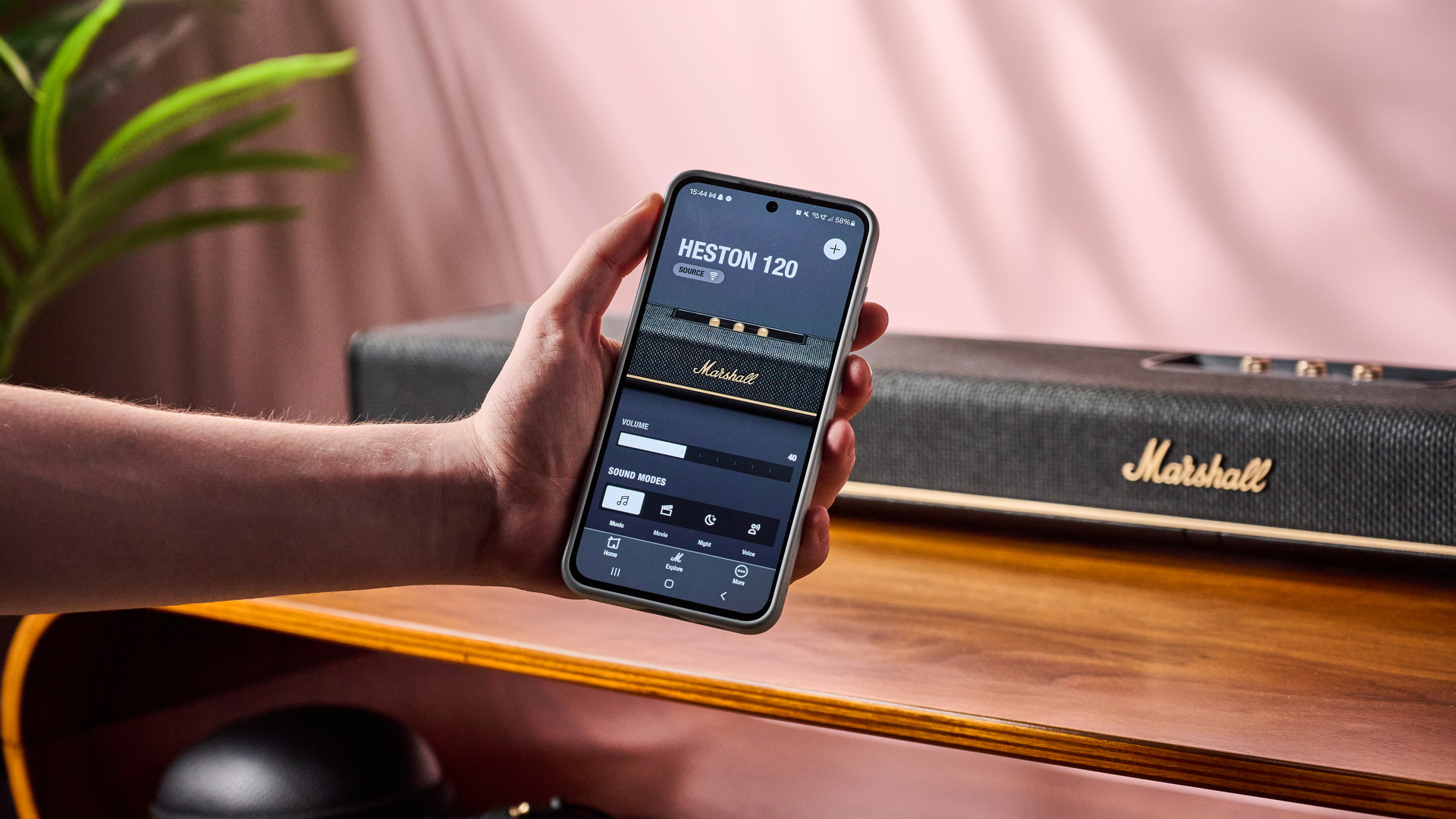
Marshall Heston 120 review: performance
- Earth-shaking bass output
- Great Atmos with impressive width and verticality
- Impeccable for music, especially stereo
So the Heston 120 gets the title of Marshall’s first ever soundbar, as the legendary audio brand takes its first step into the world of home cinema entertainment. No pressure then. From marketing alone, it’s clear that Marshall is confident in the Heston 120’s “rumbling” bass, “immersive” Dolby Atmos sound and “natural vocal clarity” – but can it live up to the hype?
Well, before I answer that, let’s go through the Heston 120’s key focal areas and see how it measures up. When I spoke to the audio engineers that worked on the Marshall Heston 120, I was told there were three focal points: Dolby Atmos for movies; Dolby Atmos music; and stereo music.
Let’s go big and start things off with Atmos for movies. I have to say, the Heston 120 performs incredibly well here. I started my testing by watching a 4K UHD Blu-Ray of Nosferatu – you know, the one where Pennywise plays the eponymous role. And even from the Universal Studios fanfare, I knew I was in for a treat, with booming bass filling our TV testing facility.
During a scene where Count Orlok confronts Ellen, the vampire’s haunting voice came through with incredible depth and haunting levels of detail, with each breathy detail and deep inhale coming through cleanly. Quaking sub-bass also rippled through part of the scene, perfectly capturing the picture’s tense, fear-inducing nature. Whether it was that giant sub-bass, frantic dialogue or piercing high-pitched screeches, the Heston was more than up to the task. I watched this film when it was first released and, honestly, the Heston had enough talent to make me feel as if I was back in the cinema.
But when I think about Atmos, I think, first and foremost about expansive, directional sound that really makes me feel part of the action. And I really want to give the Heston 120 some kudos there, because it performed very admirably indeed in that department.
When watching The Boy and the Heron, the soundbar effortlessly tracked elements such as the width of the heron’s flight path or the verticality of an arrow being fired into the sky. Similarly, when tuning into The Batman, the movement of bats flying towards me had me inching back in my seat – and the Heston gave me a genuine sense that they flew over my shoulder too.
Still, if you’re searching for the most complete surround sound on the market, you’re not going to get it from the Marshall Heston 120 – at least not right now. There are no rear speakers included to give you ultimate wraparound sound and, at the point of launch, there’s no separate sub to take low frequency output to yet another level – both things that would be ideal for those with larger living rooms especially. An option like the JBL Bar 1300X, for example, has a main soundbar with a sub and two rears, meaning you get an even more fleshed-out spatial impression.
Still, I’m here to judge the Heston 120 for what it is – not what it could be, and it really did impress me when it comes to Dolby Atmos effects, dialogue clarity and low-end punch. So, it only seems right to next tackle the area of Dolby Atmos music.
This format, I concede won’t be everyone’s favorite way to listen to tunes, but the Heston, as you’d expect, gets the best out of Atmos mixes. When blasting I’m Gonna Love You Just A Little More Baby by Barry White, I was astonished by the width of audio emitting from the Heston 120. Guitars sounded as if they were playing from the sides of the room, rather than from the bar itself, with funky drums dancing and keys dancing across the room.
That was paired with a controlled, balanced vocal performance playing from the center and a total lack of harshness or distortion, ensuring a really enjoyable and three-dimensional listening experience.
Despite all of that, I have to tell you that the absolute highlight of my time spent with the Marshall Heston 120, was listening to stereo music. That really isn’t to take away from the incredible Atmos effects – it’s just all too common for soundbars to miss the mark on musicality, but the Heston is truly class-leading.
When listening to Strange Meadow Lark by Dave Brubeck, the channel separation was phenomenal, drums subtly enter the left side, keys work their magic subtly on the right with punchy bass holding it down throughout the track without smothering the mix.
Again, with Affirmation by George Benson, every instrument was given plenty of breathing space. Each element – whether emotive strings, rhythmic percussion or smooth bass – was positioned beautifully. I genuinely sat for hours listening to albums in this format, I really couldn’t get enough.
I preferred stereo music on the Heston 120 over what the amazing Samsung HW-Q800D could offer – a soundbar that I’ve been happily using for almost half a year, so… it may be time for an upgrade.

Marshall Heston 120 review: design
- Show-stopping amp-like aesthetic
- Tactile dial controls with haptic feedback
- Though these can catch reflections from TV
So, the Heston 120 has already wowed me with its fantastic feature-set and awesome audio, but there’s one aspect that’s even more appealing. And that is, of course, its gorgeous design, infused with Marshall’s amp-making heritage and finished off with eye-catching gold details.
When I spoke to Marshall at its Stockholm HQ, I was told that the Heston 120 was meant to stand alone in a sea of homogenous black bars. And yep, it definitely does that. Even the golden plate on top of the soundbar oozes class, with three knurled metal knobs positioned alongside well-sized preset and sound mode buttons.
LED lights around the knobs also indicate volume and EQ levels as well as source, which is a nice touch. There’s no display, which some may miss, but as I mentioned earlier, the app houses all the info you’ll need.
Let’s go back to those metal dials, though, because they really are a unique design choice for a soundbar. Firstly, I should emphasize that they’re a joy to use. They’re smooth and pleasing to turn, with haptic feedback included for a more interactive user experience.
But alas… they do bring a problem to the table. When watching movies in a low-lit or dark room, I found that they were illuminated by the TV and caught some reflections. This is nothing too invasive, of course, you’re not going to be blinded by Marshall’s knobs… but it can be a touch distracting.
It’s also worth noting that I had the Heston 120 positioned right under the TV, and the reflectivity will change depending on the gap between the dials at the screen, how far the soundbar is from the TV, and where you’re sitting – and if you’ve wall-mounted them, that will also change things.
Speaking of a wall mount: you’re going to have to purchase that separately. You can grab one on Marshall’s website for $49 / £44 / AU$79 – a fair chunk less than the Sonos Arc Ultra’s mount, notably. I should also mention that the Marshall website is home to a bunch of replacement parts and an authorized repair service, just in case your Heston ever gets damaged.
Before we move on, it has to be said – the Heston is a chunky fella. It’s more than a meter long and weighs in at over 7kg. It will be well-suited under a TV sized 55-inches and up – just make sure your setup has plenty of room, or it may be a tight squeeze.
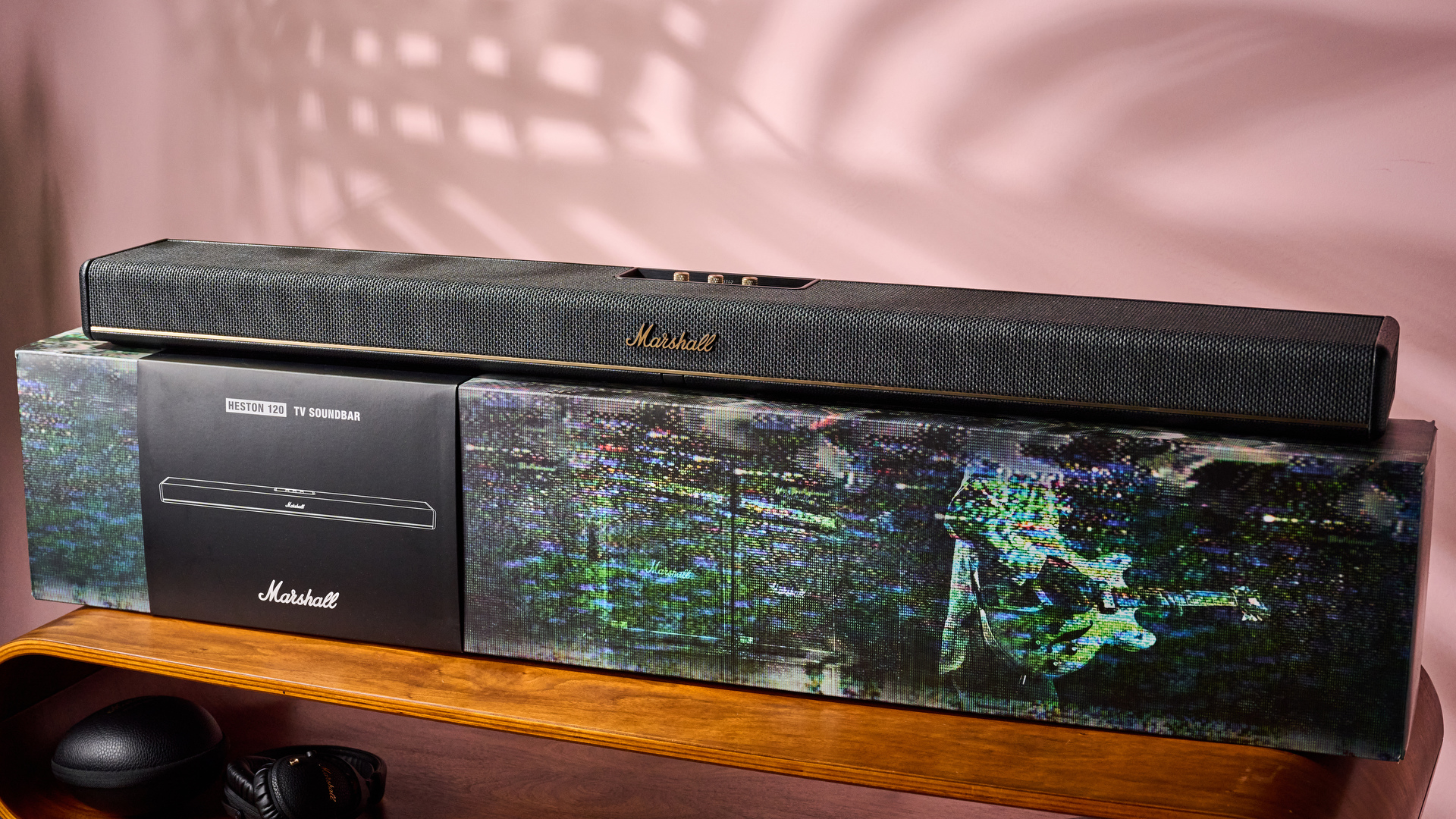
Marshall Heston 120 review: setup & usability
- Super easy to install
- Everything you need is in the Marshall app
- Huge variety of connectivity options
When it comes to getting setup and ready to go, most modern soundbars are fairly straightforward, and the Marshall Heston 120 is no different. I simply plugged in my power cable and hooked the included HDMI cord from our testing TV into the eARC slot and I was done. Yep, really, that’s all you need to do.
Of course, if you want to truly optimize the Heston 120 for your living space, then it’s well-worth heading over to the Marshall app. One of the first things I did was make use of the Room Correction feature to make sure I was making the most of this stunning soundbar’s sonic talents.
And as we discussed earlier, the app has everything a user will need, from volume controls, source switching, sound mode selection and EQ adjustment. The lack of a remote, if anything, is most welcome for me. I really like the simplicity of an all-in-one digital hub.
One of the big wins the Heston gets over its rival, the Sonos Arc Ultra, is that it has an HDMI passthrough port. That’s incredibly useful if you’ve already used up all of your TV’s HDMI slots and it was one of the main reasons we didn’t rate the Arc Ultra higher than four stars in our review.
And just generally, there really are so many ways to connect the Heston 120. You get all those integrated music services like Spotify and Tidal Connect, plenty of ports, including HDMI, RCA and USB-C, as well as Bluetooth connectivity. The only thing that some may miss at the moment is some sort of voice-assistant support. That’s something you will get on the Arc Ultra, but honestly, it’s not a feature I typically make use of on a soundbar.
- Setup & usability score: 5/5
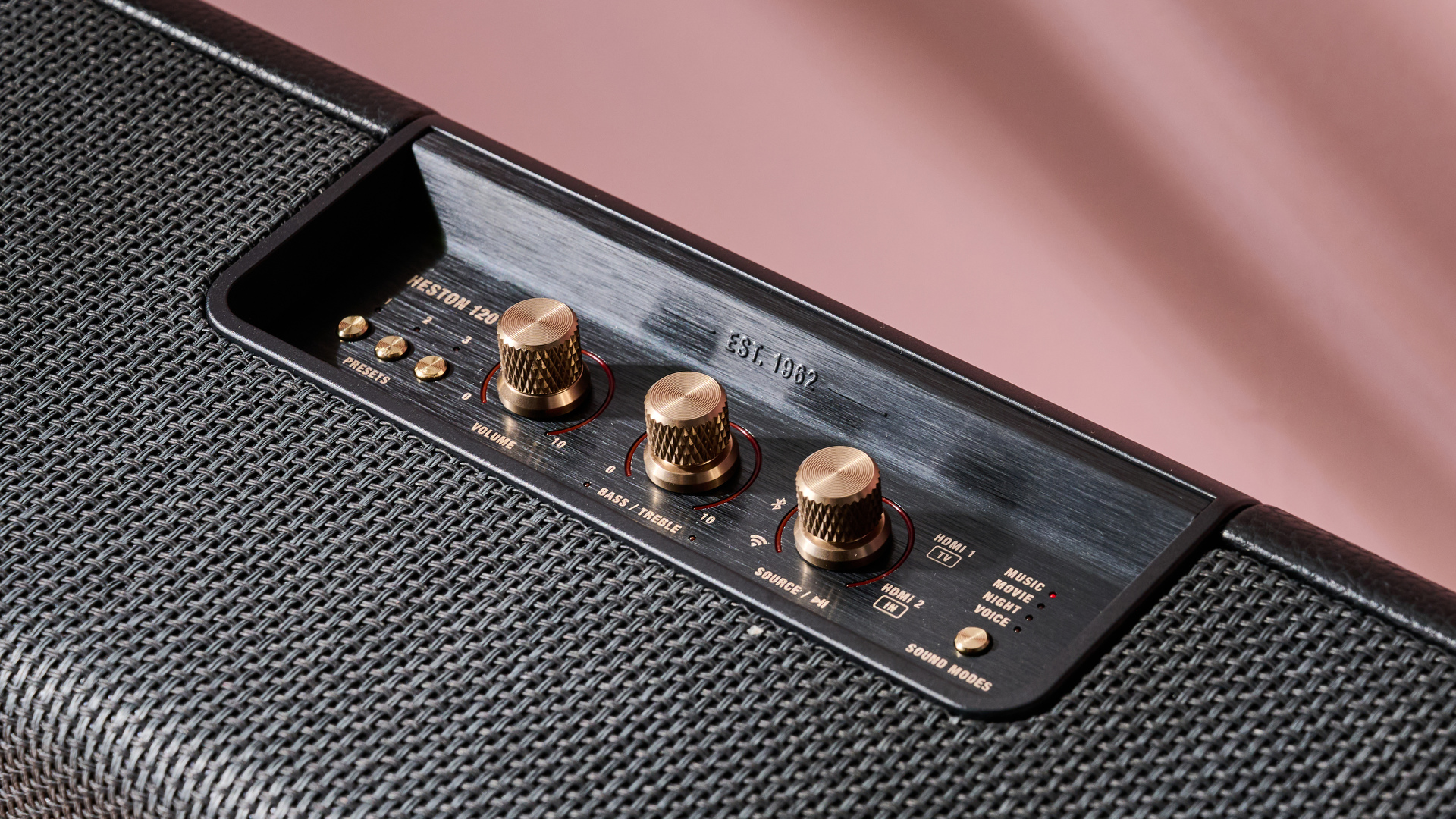
Marshall Heston 120 review: value
- Comes at quite the cost
- But is class-leading in musicality and offers awesome Atmos
- You can get strong multi-box options at a similar price
Even though I’ve raved about the Heston 120 so far, it has to be said that it is a pricey piece of kit. At $999 / £899 / AU$1,799, it’s well and truly in the premium tier. It costs the same as its all-in-one rival, the Sonos Arc Ultra – that is if you’re in the US and Australia. The Heston is £100 cheaper for those of us in the UK, though.
Having said that, the Heston 120 is still priced competitively when you consider a rival like the Sony Bravia Theater Bar 9 comes in at $400 / £500 more. At the same time, though, you could get a highly competent surround sound system for a similar cost. The excellent Samsung HW-Q990D can regularly be found now for just over $1,200 / £1,000 and that comes with dual rear speakers and a separate sub – talk about value!
Again, though, as a single box, the Heston 120 really is up there with the best of the best. I’ve not heard better musicality from any soundbar before and as an all-in-one solution, the levels of bass and expansiveness are seriously impressive. That’s not to mention the fact that this model packs in essentially every feature and connectivity type that you’d hope to see. So yes – it’s pricey – but for good reason.
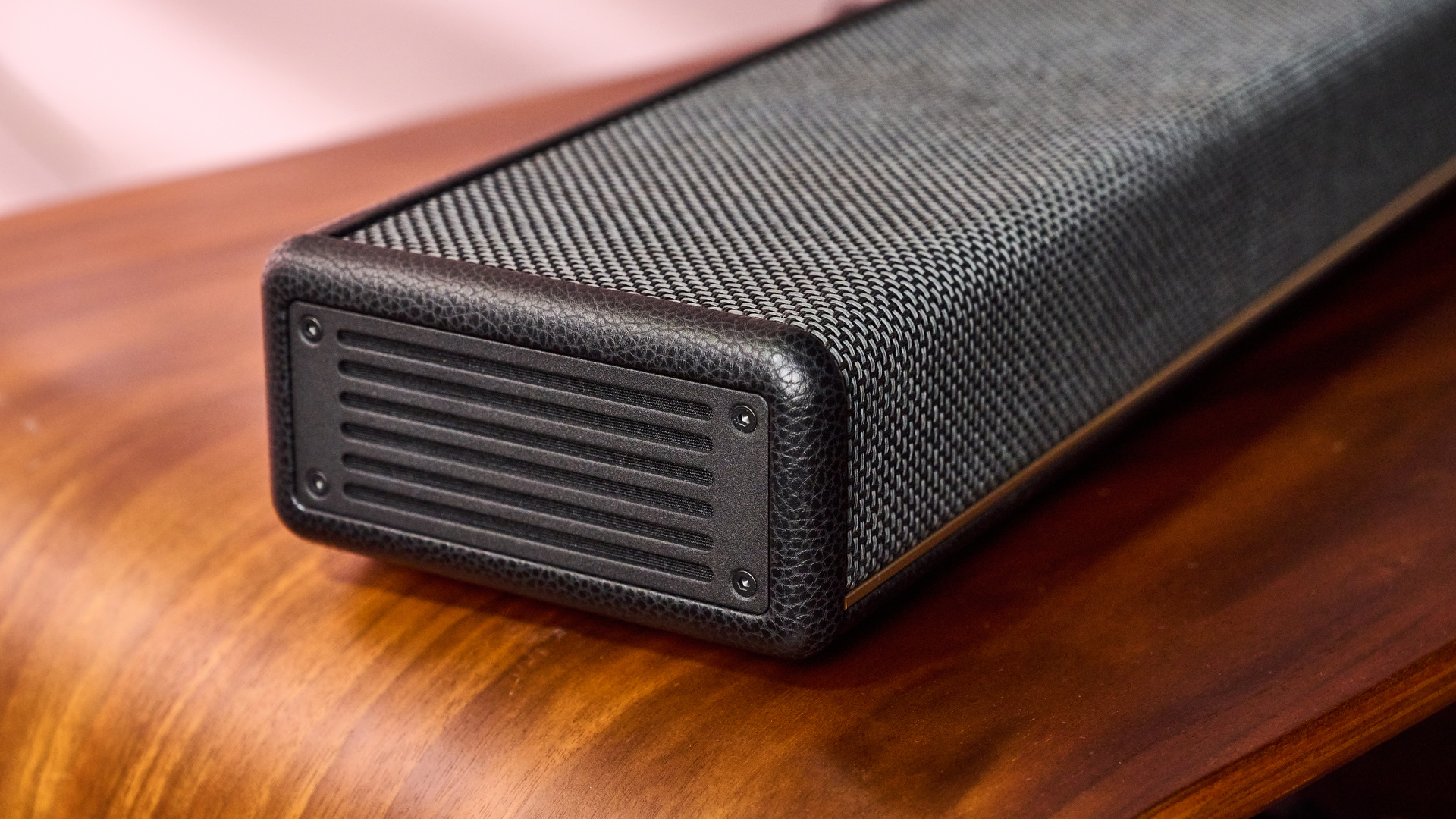
Should I buy the Marshall Heston 120?
Attributes | Notes | Rating |
|---|---|---|
Features | Tons of connectivity options, Atmos and DTS:X, great companion app. | 5/5 |
Performance | Booming bass output, excellent Atmos effects, best-in-class musicality. | 5/5 |
Design | Stunning looks, handy repairability options, dials can catch reflections. | 4.5/5 |
Setup & usability | Easy setup, app is perfect control hub, tons of connectivity options. | 5/5 |
Value | It’s pricey, but comes with a load of handy features and stellar sound. | 4/5 |
Buy it if…
Don’t buy it if…
Marshall Heston 120 review: also consider
| Header Cell – Column 0 | Marshall Heston 120 | Sonos Arc Ultra | Samsung HW-Q990D |
|---|---|---|---|
Price | $999 / £899 / AU$1,799 | $999 / £999 / AU$1,799 | $1,799 / £1,699 / AU$1,995 |
Dimensions | 43.3 x 5.7 x 3 inches / 1100 x 145 x 76mm | 2.95 x 46.38 x 4.35 inches / 75 x 1178 x 110.6mm | Soundbar: 51.3 x 23.4 x 10.9 inches / 1309 x 595 x 277mm; Subwoofer: 8.6 x 16.2 x 16.1 inches / 220 x 413 x 410mm; Rear speakers: 5 x 7.9 x 5.5 inches / 129.5 x 201.3 x 140.4mm |
Speaker channels | 5.1.2 | 9.1.4 | 11.1.4 |
Connections | 1x HDMI eARC, 1x HDMI in, RCA Stereo, RCA Mono (sub out), USB-C, Ethernet, Wi-Fi, Bluetooth 5.3 | 1x HDMI with eARC, Ethernet, Wi-Fi, Bluetooth | 1x HDMI eARC, 2x HDMI 2.1 in, optical digital audio, Wi-Fi, Bluetooth |
Dolby Atmos/DTS:X | Yes/Yes | Yes/No | Yes/Yes |
Sub included | No | No | Yes |
Rear speakers included | No | No | Yes |
How I tested the Marshall Heston 120
- Tested across a week-long period
- Used in our TV testing space at Future Labs
- Both Dolby Atmos and stereo sound tested
When testing the Marshall Heston 120, I had it hooked up to the fantastic Panasonic MZ1500 TV via HDMI eARC. I also used Tidal Connect over Wi-Fi and Spotify over Bluetooth when tuning into my favorite tracks.
During testing, the soundbar was placed in front of the TV in our TV testing space at Future Labs. I tried viewing and listening to a vast array of content during an intensive testing period. This included a number of movies and TV shows and songs on our TechRadar testing playlist. For reference, I used the Panasonic DP-UB820 to view Dolby Atmos-enabled 4K UHD Blu-rays.
On top of that, I made extensive use of each listening mode: Movie; Music; Voice; and Night. I also dug into additional options on the Marshall app, ensuring each feature functioned as advertised.
I’ve tested tons of soundbars here at TechRadar – everything from ultra-cheap options like the Hisense HS214 through to pricier models like the Samsung HW-Q800D. I’ve also got plenty of experience testing other gear, including the best Bluetooth speakers and best headphones, which helped me to assess the caliber of the Heston 120’s musicality.







Leave a Comment
Your email address will not be published. Required fields are marked *